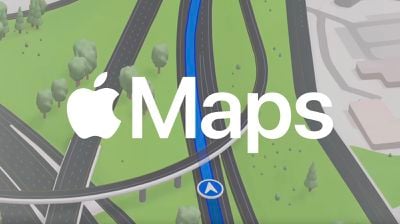Apple Collecting Data to Improve Augmented Reality Location Accuracy in Maps
With the launch of iOS 17.2, Apple has outlined the Maps-related data that it is collecting in order to improve the augmented reality location function. In a new support document, Apple says that it is aiming to bolster the speed and accuracy of augmented reality features in the Maps app.

When using augmented reality features in Maps, including immersive walking directions or the refine location option, Apple collects information on "feature points" that represent the shape and appearance of stationary objects like buildings. The data does not include photos or images, and the feature points collected are not readable by a person.
According to Apple, Maps uses on-device machine learning to compare feature points to Apple Maps reference data that is sent to the iPhone. The camera filters out moving objects like people and vehicles, with Apple collecting just the feature points of stationary objects.
The comparison between the feature points and the Apple Maps reference data allows Maps to pinpoint a user location and provide detailed walking directions with AR context. Using either the AR Walking directions or Refine Location refreshes Apple's reference data to improve augmented reality accuracy.
Data that Apple collects is encrypted and not associated with an individual user or Apple ID. Apple also uses on-device machine learning to add "noise" to the feature points data to add irregular variations that prevent any "unlikely" attempt to use feature points to reconstruct an image from the data.
According to Apple, only an "extremely sophisticated attacker" that has access to the company's encoding system would be able to recreate an image from feature points, but because the data is encrypted and limited only to Apple, "an attack and recreation are extremely unlikely."
The use of AR data can be disabled to prevent Apple from collecting it. The "Improve AR Location Accuracy" toggle can be accessed in the Settings app by going to Privacy and Security and then tapping on Analytics and Improvements.
Popular Stories
Despite being more than two years old, Apple's AirPods Pro 2 still dominate the premium wireless‑earbud space, thanks to a potent mix of top‑tier audio, class‑leading noise cancellation, and Apple's habit of delivering major new features through software updates. With AirPods Pro 3 widely expected to arrive in 2025, prospective buyers now face a familiar dilemma: snap up the proven...
Apple's iPhone development roadmap runs several years into the future and the company is continually working with suppliers on several successive iPhone models simultaneously, which is why we often get rumored features months ahead of launch. The iPhone 17 series is no different, and we already have a good idea of what to expect from Apple's 2025 smartphone lineup.
If you skipped the iPhone...
Apple is preparing a "bold" new iPhone Pro model for the iPhone's 20th anniversary in 2027, according to Bloomberg's Mark Gurman. As part of what's being described as a "major shake-up," Apple is said to be developing a design that makes more extensive use of glass – and this could point directly to the display itself.
Here's the case for Apple releasing a truly all-screen iPhone with no...
While the iPhone 17 Pro and iPhone 17 Pro Max are not expected to launch until September, there are already plenty of rumors about the devices.
Subscribe to the MacRumors YouTube channel for more videos.
Below, we recap key changes rumored for the iPhone 17 Pro models as of April 2025:
Aluminum frame: iPhone 17 Pro models are rumored to have an aluminum frame, whereas the iPhone 15 Pro and ...
If you have been experiencing issues with wireless CarPlay in your vehicle lately, it was likely due to a software bug that has now been fixed.
Apple released iOS 18.4.1 today, and the update's release notes say it "addresses a rare issue that prevents wireless CarPlay connection in certain vehicles."
If wireless CarPlay was acting up for you, updating your iPhone to iOS 18.4.1 should...
This week saw rumor updates on the iPhone 17 Pro and next-generation Vision Pro, while a minor iOS 18.4.1 update delivered not just security fixes but also a fix for some CarPlay issues.
We also looked ahead at what else is in Apple's pipeline for the rest of 2025 and even the 20th-anniversary iPhone coming in 2027, so read on below for all the details on these stories and more!
iPhone 17 ...
Apple seeded the third beta of iOS 18.5 to developers today, and so far the software update includes only a few minor changes.
The changes are in the Mail and Settings apps.
In the Mail app, you can now easily turn off contact photos directly within the app, by tapping on the circle with three dots in the top-right corner.
In the Settings app, AppleCare+ coverage information is more...






















